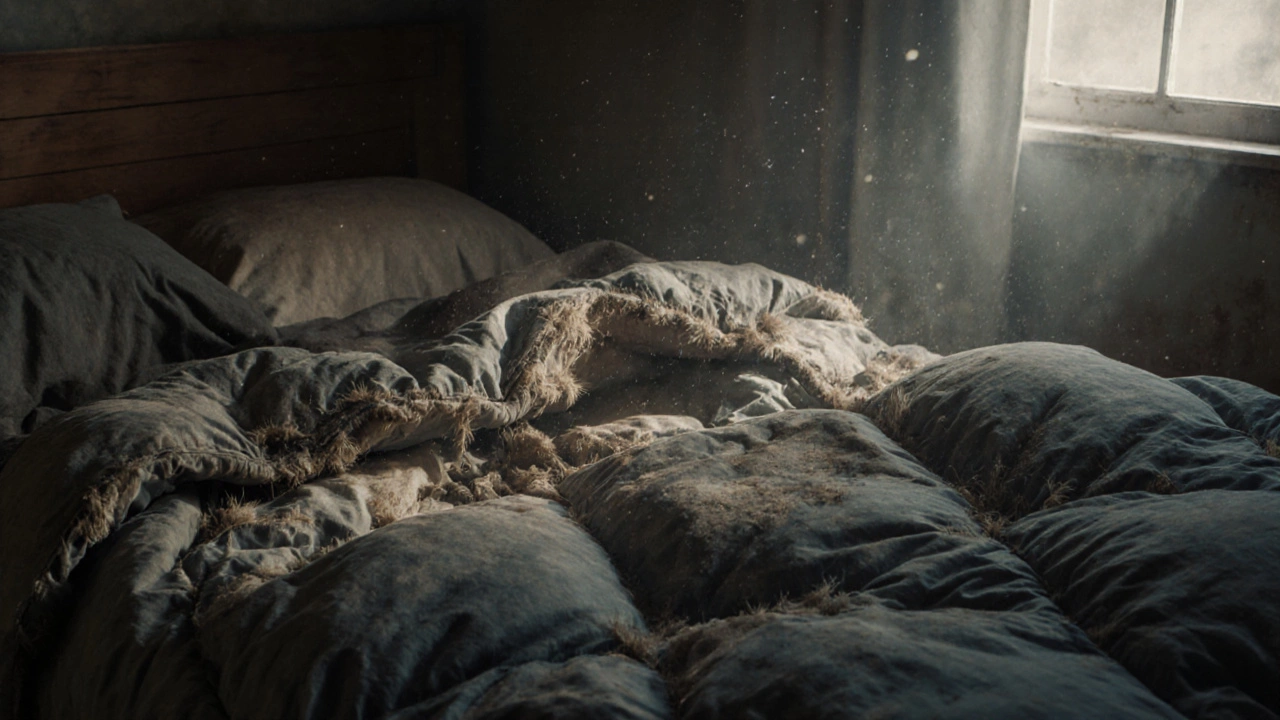Comforter Replacement Tool
Is It Time to Replace Your Comforter?
Answer these questions to determine if your comforter needs replacement.
Most people sleep with a comforter every night, but few ever stop to ask: when should you throw away a comforter? It’s not like a T-shirt that gets worn out after a few washes. A comforter lasts years - sometimes decades - but that doesn’t mean it’s still doing its job. If your comforter feels lumpy, smells faintly musty, or doesn’t warm you like it used to, it might be time to let it go. And no, tossing it in the dryer for an hour won’t fix it.
Your comforter has a lifespan - and it’s shorter than you think
Most quality comforters last between 5 and 10 years. That’s not a guess. It’s based on how the filling breaks down over time. Down and synthetic fills both lose their loft. Down clusters clump and flatten. Synthetic fibers become brittle and start to break apart. After five years of regular use, even the best comforter loses about 20% of its insulating power. After ten, that number jumps to 40% or more. You’re not just sleeping on an old blanket - you’re sleeping on something that no longer works the way it was designed to.
Look at your comforter like a pair of running shoes. You don’t wait until the sole falls off to replace them. You replace them when they stop giving you support. The same applies here. If you’re waking up cold, even with the heater on, your comforter might be the culprit - not your thermostat.
5 clear signs it’s time to replace your comforter
- It’s lumpy or uneven. If you can feel big clumps of filling shifting around under your hands, or if one side is flat while the other is puffy, the filling has broken down. This isn’t just an aesthetic issue - it creates cold spots that ruin your sleep.
- The fabric is thinning or tearing. Check the seams, corners, and areas where your arms rest. If you can see the filling poking through, or if the outer fabric feels papery and fragile, it’s no longer protecting the insulation. Dust mites and allergens can get in. Moisture can get in. Both ruin your sleep quality.
- It smells bad - even after washing. If your comforter still smells musty or sour after a full wash and dry cycle, the odor is trapped in the fibers. That’s not just unpleasant - it’s a sign of mold, mildew, or bacteria buildup. Washing can’t reach deep enough to fix it.
- You’re allergic or itchy more often. Dust mites love old, warm, humid environments. A comforter that’s been used for more than 7 years is a breeding ground. If you’ve noticed more sneezing, itchy eyes, or skin rashes after going to bed, your comforter might be the source.
- It’s too heavy or too light. Your body changes. Your sleep habits change. Maybe you used to like a heavy down comforter in winter, but now you wake up sweating. Or maybe you used to need a thick one, but now a light blanket feels enough. If your comforter no longer matches your comfort needs, it’s outlived its purpose.
What happens if you keep using an old comforter?
It’s easy to think, “It’s still warm enough,” or “I’ve had it for 12 years - why replace it?” But holding onto an old comforter isn’t saving money - it’s costing you sleep quality, health, and even your peace of mind.
Old comforters trap moisture. In Perth’s damp winters, that means condensation builds up inside the filling. That moisture feeds mold and dust mites. A 2023 study from the University of Western Australia found that comforters older than 8 years had 3 times more dust mite allergens than those under 5 years old. People with asthma or allergies saw a 40% drop in nighttime symptoms after replacing their comforters.
And then there’s the psychological effect. A worn-out comforter doesn’t just feel bad - it makes your bed feel neglected. Your bedroom should be a sanctuary. If your bedding looks tired, smells off, or doesn’t keep you warm, your brain doesn’t relax the same way. You’re not just sleeping on fabric - you’re sleeping on neglect.

How to properly dispose of an old comforter
Don’t just toss it in the bin. Most comforters are made of synthetic materials (polyester, nylon) or natural ones (down, cotton). Both can be recycled - if you know where to take them.
In Perth, organizations like Textile Recycling Australia and local council drop-off points accept old bedding. Some charities, like the Salvation Army, take clean, stain-free comforters for reuse. If your comforter is torn or smelly, it won’t be reused - but it can still be recycled into insulation or stuffing for other products.
If you’re unsure, call your local council. Most have a “soft plastics and textiles” recycling stream. Don’t let your old comforter end up in landfill if it doesn’t have to.
What to look for in a new comforter
Replacing your comforter isn’t just about buying something new. It’s about choosing the right one for your body, your climate, and your sleep habits.
- Fill type matters. Down is light and warm but expensive. Synthetic fills (like microfiber) are affordable and hypoallergenic. Wool is great for damp climates like Perth - it wicks moisture naturally.
- Weight is personal. If you sleep hot, go for a 300-400g fill weight. If you’re always cold, choose 500g or higher. Check the label - good brands list the fill weight in grams per square meter.
- Thread count isn’t everything. A 200-thread-count cotton cover with a good baffle box stitch will outlast a 600-thread-count one with poor construction. Look for double-stitched seams and a tight weave.
- Washability is key. If you can’t machine wash it, you won’t wash it often enough. Choose something that can go in a front-load washer on a gentle cycle.

How to make your new comforter last longer
Once you get a new one, don’t let it become the next one you throw away. Here’s how to extend its life:
- Use a duvet cover. Always. It’s the single best way to protect your comforter from sweat, oils, and dust.
- Wash it once every 3-4 months. More if you have pets or allergies. Use mild detergent - no bleach or fabric softener.
- Dry it thoroughly. Tumble dry on low heat with a few clean tennis balls to restore loft. Never air-dry it completely - trapped moisture causes mold.
- Store it properly. In off-seasons, keep it in a breathable cotton bag, not a plastic bin. Plastic traps moisture.
Replacing your comforter isn’t a luxury - it’s a sleep upgrade. You wouldn’t drive a car with bald tires just because it still moves. Don’t sleep on a comforter that’s lost its purpose.
How often should I replace my comforter?
Most comforters last 5 to 10 years, depending on use and care. If you use a duvet cover and wash it every few months, you can stretch it to 10. Without care, it may need replacing in as little as 3-4 years. Look for signs like lumps, odors, or cold spots - not just the calendar.
Can I wash my comforter at home?
Yes, if your washing machine is large enough - usually a front-loader with at least a 7kg capacity. Use a gentle cycle with cold or warm water and mild detergent. Avoid fabric softener - it coats fibers and reduces loft. Dry on low heat with tennis balls to fluff it up. If your machine is too small, take it to a laundromat with industrial machines.
Is it better to buy down or synthetic comforters?
Down is warmer and lighter, but expensive and not hypoallergenic. Synthetic fills are cheaper, easier to clean, and better for allergies. In Perth’s humid climate, synthetic or wool are often better choices because they resist moisture. Down works well in dry, cold climates.
What’s the best weight for a comforter in Perth?
For Perth’s mild winters and cool nights, a 400-500g fill weight is ideal. That’s warm enough for winter but not too hot for spring or autumn. If you sleep hot, go for 300-400g. If you’re always chilly, choose 500g or higher. Always check the label - reputable brands list fill weight in grams per square meter.
Can I donate my old comforter?
Only if it’s clean, odor-free, and in good condition - no tears, stains, or lumps. Charities like the Salvation Army and Vinnies accept them for reuse. If it’s damaged or smells, don’t donate it - recycle it instead. Most local councils in Perth have textile recycling drop-off points for worn-out bedding.
Final thought: Your sleep deserves better
You spend a third of your life in bed. That’s over 8 years of your life - just sleeping. Would you use a 12-year-old mattress? A 10-year-old pillow? Then why keep an old comforter? It’s not about being wasteful. It’s about respecting your body’s need for warmth, comfort, and clean air while you rest.
Replacing your comforter isn’t a chore. It’s a small, simple upgrade that improves your sleep, your health, and your mood. Do it before the next winter hits. Your future self will thank you.
